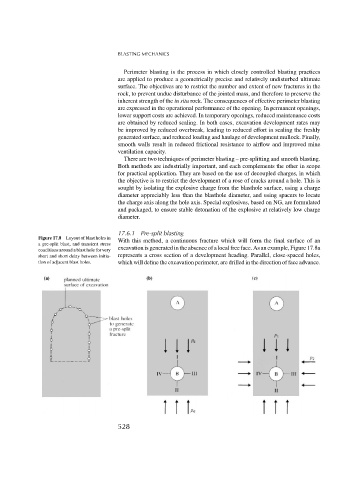Page 546 - Rock Mechanics For Underground Mining
P. 546
BLASTING MECHANICS
Perimeter blasting is the process in which closely controlled blasting practices
are applied to produce a geometrically precise and relatively undisturbed ultimate
surface. The objectives are to restrict the number and extent of new fractures in the
rock, to prevent undue disturbance of the jointed mass, and therefore to preserve the
inherent strength of the in situ rock. The consequences of effective perimeter blasting
are expressed in the operational performance of the opening. In permanent openings,
lower support costs are achieved. In temporary openings, reduced maintenance costs
are obtained by reduced scaling. In both cases, excavation development rates may
be improved by reduced overbreak, leading to reduced effort in scaling the freshly
generated surface, and reduced loading and haulage of development mullock. Finally,
smooth walls result in reduced frictional resistance to airflow and improved mine
ventilation capacity.
There are two techniques of perimeter blasting – pre-splitting and smooth blasting.
Both methods are industrially important, and each complements the other in scope
for practical application. They are based on the use of decoupled charges, in which
the objective is to restrict the development of a rose of cracks around a hole. This is
sought by isolating the explosive charge from the blasthole surface, using a charge
diameter appreciably less than the blasthole diameter, and using spacers to locate
the charge axis along the hole axis. Special explosives, based on NG, are formulated
and packaged, to ensure stable detonation of the explosive at relatively low charge
diameter.
17.6.1 Pre-split blasting
Figure 17.8 Layout of blast holes in With this method, a continuous fracture which will form the final surface of an
a pre-split blast, and transient stress
conditions around a blast hole for very excavation is generated in the absence of a local free face. As an example, Figure 17.8a
short and short delay between initia- represents a cross section of a development heading. Parallel, close-spaced holes,
tion of adjacent blast holes. which will define the excavation perimeter, are drilled in the direction of face advance.
528

